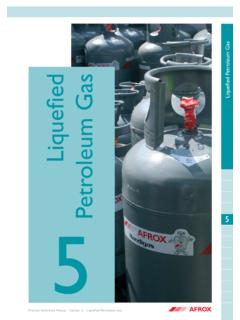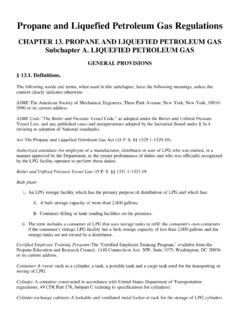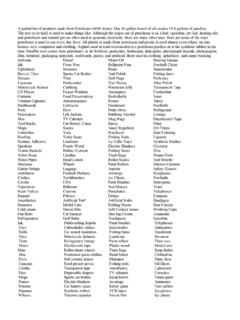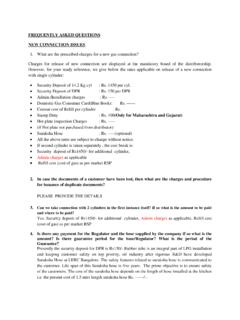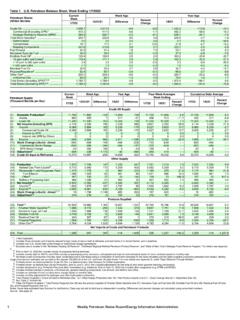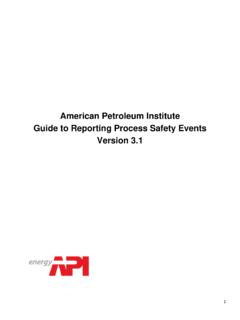Transcription of 1.5 Liquefied Petroleum Gas Combustion
1 07/08 External Combustion Liquefied Petroleum Gas General1 Liquefied Petroleum gas (LPG or LP-gas) consists of propane , propylene, butane, andbutylenes; the product used for domestic heating is composed primarily of propane . This gas, obtainedmostly from gas wells (but also, to a lesser extent, as a refinery by-product) is stored as a liquid undermoderate pressures. There are three grades of LPG available as heating fuels: commercial-gradepropane, engine fuel-grade propane (also known as HD-5 propane ), and commercial-grade butane. Inaddition, there are high-purity grades of LPG available for laboratory work and for use as aerosolpropellants.
2 Specifications for the various LPG grades are available from the American Society forTesting and Materials and the Gas Processors Association. A typical heating value for commercial-grade propane and HD-5 propane is 90,500 British thermal units per gallon (Btu/gal), aftervaporization; for commercial-grade butane, the value is 97,400 Btu/gal. The largest market for LPG is the domestic/commercial market, followed by the chemicalindustry (where it is used as a petrochemical feedstock) and the agriculture industry. propane is alsoused as an engine fuel as an alternative to gasoline and as a standby fuel for facilities that haveinterruptible natural gas service Firing Practices2 The Combustion processes that use LPG are very similar to those that use natural gas.
3 Use ofLPG in commercial and industrial applications may require a vaporizer to provide the burner with theproper mix of air and fuel. The burner itself will usually have different fuel injector tips as well asdifferent fuel-to-air ratio controller settings than a natural gas burner since the LPG stoichiometricrequirements are different than natural gas requirements. LPG is fired as a primary and backup fuel insmall commercial and industrial boilers and space heating equipment and can be used to generate heatand process steam for industrial facilities and in most domestic appliances that typically use natural Emissions1, Criteria Pollutants -LPG is considered a "clean" fuel because it does not produce visible emissions.
4 However,gaseous pollutants such as nitrogen oxides (NOx), carbon monoxide (CO), and organic compounds areproduced as are small amounts of sulfur dioxide (SO2) and particulate matter (PM). The mostsignificant factors affecting NOx, CO, and organic emissions are burner design, burner adjustment,boiler operating parameters, and flue gas venting. Improper design, blocking and clogging of the fluevent, and insufficient Combustion air result in improper Combustion and the emission of aldehydes, CO,hydrocarbons, and other organics. NOx emissions are a function of a number of variables, includingtemperature, excess air, fuel and air mixing, and residence time in the Combustion zone.
5 The amount ofSO2 emitted is directly proportional to the amount of sulfur in the fuel. PM emissions are very low andresult from soot, aerosols formed by condensable emitted species, or boiler scale dislodged duringcombustion. Emission factors for LPG Combustion are presented in Table Table presents emission factors on a volume basis (lb/103gal). To convert to an energybasis (lb/MMBtu), divide by a heating value of MMBtu/103gal for propane and 102 MMBtu/103gal for Greenhouse Gases6-11 -Carbon dioxide (CO2), methane (CH4), and nitrous oxide (N2O) emissions are all producedduring LPG Combustion . Nearly all of the fuel carbon ( percent) in LPG is converted to CO2 duringthe Combustion process.
6 This conversion is relatively independent of firing configuration. Although theformation of CO acts to reduce CO2 emissions, the amount of CO produced is insignificant compared tothe amount of CO2 produced. The majority of the percent of fuel carbon not converted to CO2 isdue to incomplete Combustion in the fuel FACTORS07/08 Formation of N2O during the Combustion process is governed by a complex series of reactionsand its formation is dependent upon many factors. Formation of N2O is minimized when combustiontemperatures are kept high (above 1475oF) and excess air is kept to a minimum (less than 1 percent). Methane emissions are highest during periods of low-temperature Combustion or incompletecombustion, such as the start-up or shut-down cycle for boilers.
7 Typically, conditions that favorformation of N2O also favor emissions of ControlsThe only controls developed for LPG Combustion are to reduce NOx emissions. NOx controlshave been developed for firetube and watertube boilers firing propane or butane. Vendors are nowguaranteeing retrofit systems to levels as low as 30 to 40 ppm (based on 3 percent oxygen). Thesesystems use a combination of low-NOx burners and flue gas recirculation (FGR). Some burner vendorsuse water or steam injection into the flame zone for NOx reduction. This is a trimming technique whichmay be necessary during backup fuel periods because LPG typically has a higher NOx-formingpotential than natural gas; conventional natural gas emission control systems may not be sufficient toreduce LPG emissions to mandated levels.
8 Also, LPG burners are more prone to sooting under themodified Combustion conditions required for low NOx emissions. The extent of allowable combustionmodifications for LPG may be more limited than for natural NOx control system that has been demonstrated on small commercial boilers is FGR. NOxemissions from propane Combustion can be reduced by as much as 50 percent by recirculating about 16percent of the flue gas. NOx emission reductions of over 60 percent have been achieved with FGR andlow-NOx burners used in Updates Since the Fifth EditionThe Fifth Edition was released in January 1995. Revisions to this section since that date aresummarized below.
9 For further detail, consult the memoranda describing each supplement or thebackground report for this section. Supplement A, February 1996No B, October 1996 CText was added concerning firing CO2 emission factor was factors were added for N2O and 2008 The PM filterable, NOx, CO and TOC emissions factors were updated and the PM condensableand PM total emissions factors were added using the revised PM, NOx, CO and TOC emissionsfactors for natural gas Combustion for small boilers (see July 1998 revisions to section , NaturalGas Combustion ).07/08 External Combustion EMISSION FACTORS FOR LPG COMBUSTIONaEMISSION FACTOR RATING: EPollutantButane Emission Factor(lb/103 gal) propane Emission Factor(lb/103 gal)Industrial Boilersb(SCC 1-02-010-01)CommercialBoilersc(SCC 1-03-010-01)Industrial Boilersb(SCC 1-02-010-02)CommercialBoilersc(SCC 1-03-010-02)PM, Filterable , , ,j14,30014,30012,50012, PM, CO, and TOC emissions are the same, on a heat input basis, as for natural gas Combustion .
10 Use heat contents of x 106 Btu/103 gallon for propane , 102 x 106 Btu/103 gallon forbutane, 1020 x 106 Btu/106 scf for methane when calculating an equivalent heat input basis. Forexample, the equation for converting from methane s emissions factors to propane s emissionsfactors is as follows: lb pollutant/103 gallons of propane = (lb pollutant /106 ft3 methane) * ( x106 Btu/103 gallons of propane ) / (1020 x 106 Btu/106 scf of methane). The NOx emission factorshave been multiplied by a correction factor of , which is the approximate ratio of propane /butaneNOx emissions to natural gas NOx emissions. To convert from lb/103 gal to kg/103 L, multiply SCC = Source Classification input capacities generally between 10 and 100 million input capacities generally between and 10 million particulate matter (PM) is that PM collected on or prior to the filter of an EPA Method 5 (orequivalent) sampling train.










